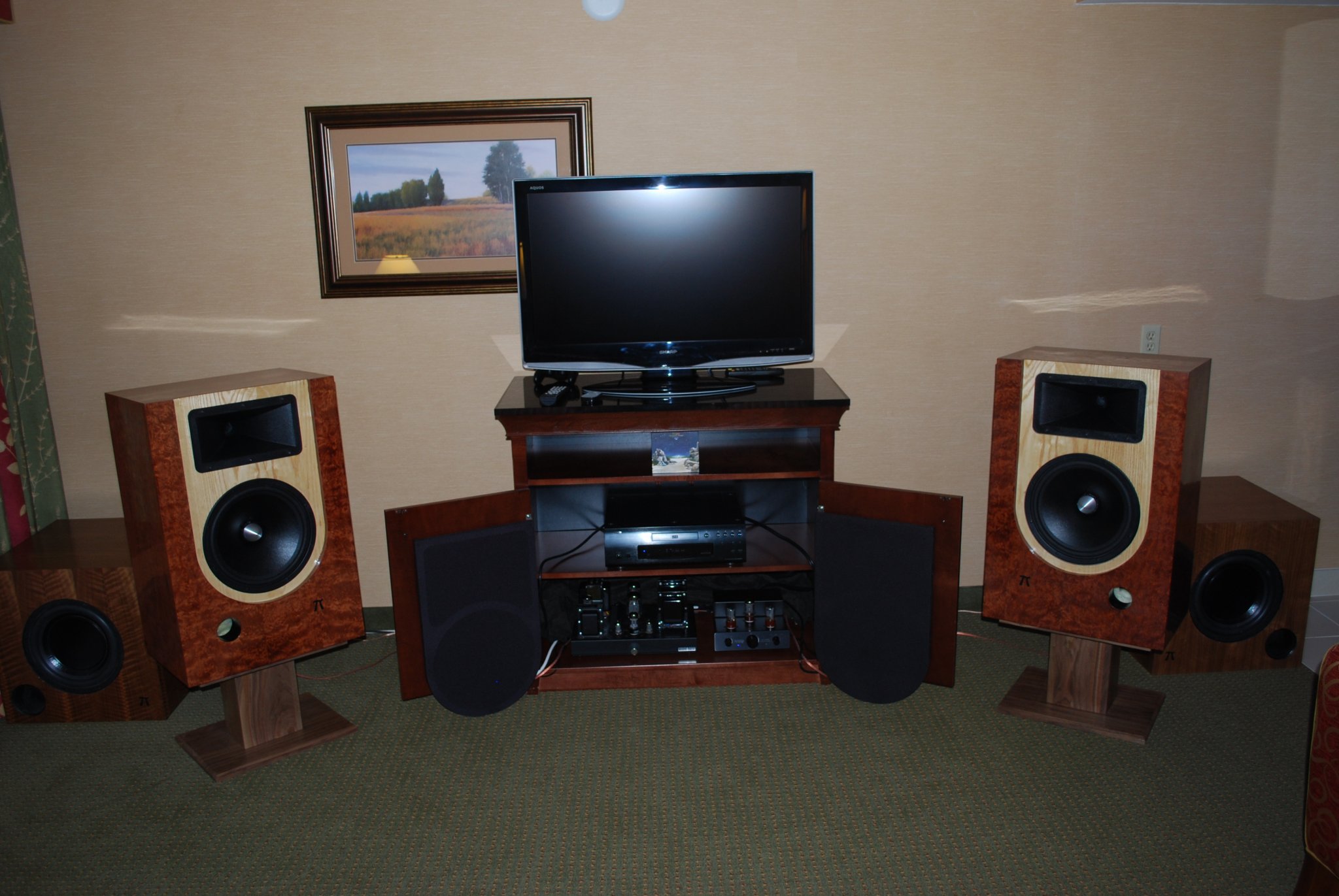|
Home » Sponsored » Pi Speakers » Helper Woofer Location
| Re: Helper Woofer Location [message #69874 is a reply to message #69872] |
Mon, 24 October 2011 17:36   |
 |
 Wayne Parham
Wayne Parham
Messages: 18985
Registered: January 2001
|
Illuminati (33rd Degree) |
|
|
The best approach for the helper woofer is to locate it physically between the main midwoofer and the nearest room boundaries. So you might want to put the helper woofer on the back, near the bottom. I sometimes call this a "flanking sub" approach, because I usually do it with a separate woofer in its own cabinet.
You aren't looking for phase coherence, actually just the opposite. We're looking for phase difference. If the mains were coherent with reflections off the walls, ceiling and floor, we wouldn't need flanking subs. But they're not, and the interference that results creates distinct peaks and dips in various places throughout the room, especially at low and low/mid frequencies in the modal range. So we have to abandon the idea of coherent summation, and go for the nest best thing, which is dense interference. It makes the modal range act a little more like the reverberant field, statistically averaged in a sort of homogenous sound distribution throughout the room.
What you really want is for the helper woofer to be in between the main speaker and the floor, and also between the main speaker and the wall behind it. That way, self-interference from those two boundaries is mitigated, as are the higher frequency vertical modes that usually manifest in this range. It doesn't need to be run any higher than the Schroeder frequency, which is around 200Hz. Drive it with a low-passed version of the same signal sent to the main speaker it is flanking.
The way it works truly is by filling in the holes caused by self-interference. At some places in the room, direct sound from the main speaker and reflection from the walls causes a cancellation notch. Said another way, at some frequencies, direct sound from the main speaker and reflection from the walls causes a cancellation notch at the listening position. But by placing a helper woofer or "flanking sub" in a different position in 3D space, the self-interference notches for the helper woofer will be at a different frequency. Where one sound source is cancelled, the other is not. The end result is response ripple is reduced by as much as 10dB. What may have been a 15dB-20dB hole without flanking subs becomes a much smaller 6db hole when flanking subs are used.
The most common way to implement flanking subs is with mains on stands, and flanking subs on the ground right beside them. The mains in the recommended crossed-axes position will naturally be two to three feet from the wall behind them and the stands typically bring midwoofer height around two feet off the floor. Flanking subs would then be placed beside, below and behind the mains, by being on the ground, and pushed back to the wall.
 three π Speakers with flanking subs
three π Speakers with flanking subs
I find subs being outside the mains usually works best in small rooms, but having them inside, between the mains is better in larger rooms. A good rule of thumb is if the distance between left and right speakers is greater than the distance between the mains to the ipsilateral (closest side) walls, bring the flanking subs inboard. If not, leave them outboard.
The best approaches seem to be where the flanking woofer is run to somewhere between 150Hz and 250Hz, with a gentle first or second-order slope. Sometimes flaking subs work best with low-pass set a little lower, like around 100Hz, which then still blends into the mid-100s or so. Helper woofers placed closer to the mains - such as is often the case in 2.5-way speakers - can generally be run higher without localization problems.
Flanking subs do not get a summed signal - They get the same signal as the main speaker they are flanking, with a low-pass filter applied. They're stereo subs. That's one of the key distinctions between flanking subs and more distant subs in a multisub configuration. Flanking subs are closer than the more distant subs, and they are sent a low-passed copy of the same signal as the mains they're flanking. Distant multisubs get a summed signal, usually low-passed at a fairly low frequency around 50Hz to 60Hz.
I like flanking woofers to be at least a couple feet away, but not more than about four feet away. More distant subs can be used to smooth lower bass modes. Flanking subs are specifically there to help the upper bass and lower midrange where distant sound sources would become localizable. Above the Schroeder frequency, the flanking sub is rolled off, so the mains become a point source. But in the modal region, acoustically distant spacing between sources ensures that where one source suffers a self-interference notch, the other source fills it in.
The goal is for the speaker to act as a point source above the Schroeder frequency, which requires spacing between sources to be acoustically close. But below the Schroeder frequency, we want dense interference, which requires that the sources be acoustically distant. The tricky part is the transition.
I find that a gentle slope works best, gradually rolling off the helping woofer below around 200Hz. It's a balancing act, because more distance allows modal smoothing to work at lower frequencies, but it also prevents this technique from being usable up high. The further apart the sound sources are, the easier it is to localize the flanking sub, so the further away it is, the lower the frequency limit where it can be used.
|
|
|
|
Current Time: Wed Dec 17 04:15:27 CST 2025
|







